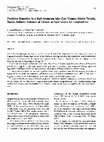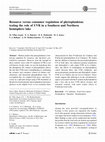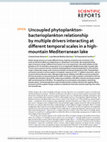Papers by Presentación Lechuga
The Landscape of the Sierra Nevada
Continental Shelf Research, Sep 1, 2019
Short term primary production in western Mediterranean Sea phytoplankton communities subjected to... more Short term primary production in western Mediterranean Sea phytoplankton communities subjected to the combined stress of high irradiance and low nutrients during summer stratification, Continental Shelf Research (2019), doi:
Hydrobiologia, Apr 13, 2016
All in-text references underlined in blue are linked to publications on ResearchGate, letting you... more All in-text references underlined in blue are linked to publications on ResearchGate, letting you access and read them immediately.
As a consequence of global change, modifications in the interaction among abiotic stressors on aq... more As a consequence of global change, modifications in the interaction among abiotic stressors on aquatic ecosystems have been predicted. Among other factors, UVR transparency, nutrient inputs and shallower epilimnetic layers could alter the trophic links in the microbial food web. Currently, there are some evidences of higher sensi-BGD
Verhandlungen, May 1, 1998
Verhandlungen, Dec 1, 1990

Springer eBooks, 1994
A detailed sampling programme during the ice-free season (July-September) in the oligotrophic lak... more A detailed sampling programme during the ice-free season (July-September) in the oligotrophic lake Las Yeguas (Southern Spain) has shown a well-defined time lag between phytoplankton and zooplankton maximum standing stocks, the former displaying a peak (23 plgC-') just after the ice-melting, and the latter by the end of September (80 pgC 1-). A ratio of autotrophs to heterotrophs lower than 1 which lasted more than two thirds of the study period may suggest a high algal productivity per unit of biomass. The estimated strong top-down regulation of phytoplankton by zooplankton indicates an efficient utilization of resources. A comparative analysis between the available food supply and the critical food concentration that is necessary to maintain the population of Daphnia pulicaria (which constitutes up to 98 % of the heterotrophic biomass) proves this species to be food-limited in the lake under study. To explain the dominance (and development) of such large-bodied cladoceran population, we discuss the possibility of the utilization of naked protozoan ciliates (Oligotrichidae) as a complementary high quality food source, and the exploitation of benthic resources through a coupled daily migration behaviour.
Verhandlungen, Mar 1, 1991

Scientific Reports, Apr 10, 2020
The original version of this Article contained missing bar chart outlines and missing error bars ... more The original version of this Article contained missing bar chart outlines and missing error bars in all figures. Additionally, in Figure 1 the figure key was incorrect. The individual groups for "Crysophyceae", "Bacillariophyceae" and "Dinophyceae" are now in one group "Others". As a result, the legend of Figure 1 was incorrect. "Sestonic N:P ratio (on a molar basis), phytoplankton abundance (PA) and chlorophyll a (Chl a) concentration under full sunlight (UVR + PAR) and photosynthetically active radiation (PAR) and under ambient phosphorus (P) concentration and Padded conditions. Bars represent the mean values and error bars represent the standard deviation (SD) (n = 3). " now reads: "Sestonic N:P ratio (on a molar basis), phytoplankton abundance (PA) and chlorophyll a (Chl a) concentration under full sunlight (UVR + PAR) and photosynthetically active radiation (PAR) and under ambient phosphorus (P) concentration and Padded conditions. In Fig. 1b, Others group includes Cryptophyceae, Bacillariophyceae and Dinophyceae, and represents a small proportion of the total phytoplankton abundance. Bars represent the mean values and error bars represent the standard deviation (SD) (n = 3). " This has now been corrected in the PDF and HTML versions of the original article.
Archiv Fur Hydrobiologie, 1994

En este trabajo se aborda el estudio de las interacciones troficas fitoplancton-zooplancton, medi... more En este trabajo se aborda el estudio de las interacciones troficas fitoplancton-zooplancton, mediante el analisis experimental "in situ" utilizando microcosmos. Se han ensayado el efecto de diferentes variables sobre la comunidad fitoplanctonica, entre las que destacamos a) presion de pastoreo o "grazing", mediante manipulacion de las densidades de predadores, b) composicion especifica de la comunidad zooplanctonica, realizando los experimentos en momentos del periodo libre de hielo en los que se desarrollan distintas especies o diferentes estadios de desarrollo de la especie dominante mixodiaptomus laciniatus; y c) volumen del microcosmos, utilizando dos tamanos de encerramientos (15 l o 350 l de capacidad). De los resultados obtenidos destacamos: la desaparicion de las especies flageladas de todos los encerramientos de pequeno volumen y su diferente desarrollo en las de mayor tamano es una evidencia a favor de su comportamiento migratorio, seguramente como meca...

Hydrobiologia, Jun 9, 2017
Models predict that phytoplankton is bottom-up regulated by resources and top-down controlled by ... more Models predict that phytoplankton is bottom-up regulated by resources and top-down controlled by consumers. However, how the strength of these controls varies with UV radiation (UVR) is not well known. In this study, we test the hypothesis that the phosphorus (P) content of phytoplankton affects the role that UVR exerts strengthening or weakening the resource and consumer control on distinct stoichiometric and functional phytoplankton traits. To accomplish this, we coupled field meso-and microcosms in a split-plot design using UVR treatments at the plot level and nutrients and zooplankton (presence/ absence) at the subplot level, in two mountain lakes characterized by their P-sufficient (La Caldera) and P-deficient phytoplankton (Los Cántaros). We found that the addition of nutrients decreased phytoplankton C:P in both lakes, but enhanced primary production and chlorophyll a only under UVR in La Caldera. Also, the effects of zooplankton on phytoplankton varied between lakes and UVR conditions, and increased primary production and chlorophyll a under UVR in La Caldera, but not in Los Cántaros. These results suggest that differences in the stoichiometric aspects associated with the P content in phytoplankton play a key role in how UVR affects resource and consumer controls, with much weaker effects in P-deficient food webs.

Archiv Fur Hydrobiologie, Oct 23, 1995
Quantity and ETS-activity of the plankton and those of the biofilm in the high-mountain lake La C... more Quantity and ETS-activity of the plankton and those of the biofilm in the high-mountain lake La Caldera (altitude: 3040 m a.s.l.) were studied in August-September, 1992 and 1993. The quantity of the biofilm, covering the bed stones sometimes reached 1 kg wet mass m -2 . Its ETS-activity exceeded by 2.5-5 times, that of the phytoplankton and, by 8.33-22 times, that of the zooplankton, projecting 1 m 2 surface area of the lake. The substrate kinetics of its ETS suggested eucaryotic property. The plankton concentrated in the deeper water in day time and elevated to the upper water layers by evenings. The daily respiratory carbon loss of the zooplankton, estimated from the ETS-activity was equivalent with 34-38 % of the planktonic primary production. The results indicated that the metabolically most active zone was forced to the profound, probably by the intensive UV-b radiation.

Scientific Reports, Jan 15, 2020
Global-change stressors act under different timing, implying complexity and uncertainty in the st... more Global-change stressors act under different timing, implying complexity and uncertainty in the study of interactive effects of multiple factors on planktonic communities. We manipulated three types of stressors acting in different time frames in an in situ experiment: ultraviolet radiation (UVR); phosphorus (P) concentration; temperature (T) in an oligotrophic Mediterranean high-mountain lake. The aim was to examine how the sensitivity of phytoplankton and bacterioplankton to UVR and their trophic relationship change under nutrient acclimation and abrupt temperature shifts. Phytoplankton and bacteria showed a common pattern of metabolic response to UVR × p addition interaction, with an increase in their production rates, although evidencing an inhibitory UVR effect on primary production (PP) but stimulatory on bacterial production (HBP). An abrupt T shift in plankton acclimated to UVR and P addition decreased the values of PP, evidencing an inhibitory UVR effect, whereas warming increased HBP and eliminated the UVR effect. The weakening of commensalistic and predatory relationship between phyto-and bacterioplankton under all experimental conditions denotes the negative effects of present and future global-change conditions on planktonic food webs towards impairing C flux within the microbial loop.

Journal Of Geophysical Research: Biogeosciences, Aug 1, 2017
Autotrophic picoplankton (APP) is responsible for the vast majority of primary production in olig... more Autotrophic picoplankton (APP) is responsible for the vast majority of primary production in oligotrophic marine areas, such as the Alboran Sea. The increase in atmospheric dust deposition (e.g., from Sahara Desert) associated with global warming, together with the high UV radiation (UVR) on these ecosystems, may generate effects on APP hitherto unknown. We performed an observational study across the Alboran Sea to establish which factors control the abundance and distribution of APP, and we made a microcosm experiment in two distinct areas, nearshore and offshore, to predict the joint UVR × dust impact on APP at midterm scales. Our observational study showed that temperature (T) was the main factor explaining the APP distribution whereas total dissolved nitrogen positively correlated with APP abundance. Our experimental study revealed that Saharan dust inputs reduced or inverted the UVR damage on the photosynthetic quantum yield (Φ PSII) and picoplanktonic primary production (PP P) in the nearshore area but accentuated it in the offshore. This contrasting effect is partially explained by the nonphotochemical quenching, acting as a photorepair mechanism. Picoeukaryotes reflected the observed effects on the physiological and metabolic variables, and Synechococcus was the only picoprokaryotic group that showed a positive response under UVR × dust conditions. Our study highlights a dual sensitivity of nearshore versus offshore picoplankton to dust inputs and UVR fluxes, just at the time in which these two global-change factors show their highest intensities and may recreate a potential future response of the microbial food web under global-change conditions.

Hydrobiologia, Nov 1, 1995
We examine the development of Hexarthra bulgarica (Wisniewski) populations in relation to thermal... more We examine the development of Hexarthra bulgarica (Wisniewski) populations in relation to thermal stability in natural environments. A high frequency sampling program was developed simultaneously in two high mountain lakes: a shallow one, with daily large temperature changes but little surface-bottom temperature difference and a deeper one with more stable temperature but vertical heterogeneity in the water profile. Since the capacity of H. bulgarica to perform vertical migrations in these lakes of Sierra Nevada is already known, we have studied the relationship between egg ratios and chlorophyll-a concentration, mean temperatures and temperature instability (measured as the daily rate of temperature change — TCR — as well as the surface-bottom temperature difference — SBT -) in both lakes. Results show that the intensity of temperature fluctuations has a positive effect on the egg-ratios, as TCR is only correlated with that variable in the shallow lake and SBT is only correlated with egg-ratios in the deeper one.

Biodiversity and Conservation
Identifying and quantifying global change impacts on biotic and abiotic components of ecosystems ... more Identifying and quantifying global change impacts on biotic and abiotic components of ecosystems is critical to promote an effective adaptation that increases the success of conservation strategies. To achieve this goal, global and regional assessment efforts require certain degree of harmonization on local monitoring programs to establish relevant comparisons at different spatio-temporal scales. Otherwise, the lack of harmonization might hinder the detection and assessment on the effects of human impacts. In this work we have compiled information on freshwater monitoring programs located in areas of intensive research and conservation interest: International Long Term Ecological Research (ILTER) nodes and mountain National Parks. We aimed at evaluating the quality and robustness of these programs to assess the impact of global change, addressing from the worldwide to the European and Spanish national scale. Results highlighted that freshwater monitoring programs lack a common strat...

Microbial Ecology
The Metabolic Theory of Ecology (MTE) predicts that the temperature increases exert a common effe... more The Metabolic Theory of Ecology (MTE) predicts that the temperature increases exert a common effect on organisms stimulating metabolic rates, this being stronger for a heterotrophic than for an autotrophic metabolism. However, no available studies within the MTE framework have focused on organisms' response under fluctuation at high temperature interacting with factors such as nutrient availability, or how this interaction could affect the coexistence between mixotrophic and strict autotrophic phytoplankton. Hence, we assess how the phytoplankton metabolism and species composition are affected under scenarios of high temperature and fluctuation at high temperature, and how nutrients alter the direction and magnitude of such impact. For that, we use a mixed culture composed of two phytoplankton species: a strict autotrophic species and a mixotrophic species. Our results indicate that, in agreement with the MTE, only fluctuation at high temperature treatment registered a greater activation energy (Ea) value for respiration than for primary production and stimulated mixotrophic over strict autotrophic species abundance compared to control treatment. Remarkably, fluctuation at high temperature had a strong negative impact on the total abundance of the mixed-culture. The interaction between nutrient enrichment and fluctuation at high temperature increased abundance of the strict autotrophic species and overall species abundance, and led to Ea values that were higher in primary production than in respiration. Changes in community composition, enhanced by nutrient enrichment, could be behind this response, which can have implications in ecosystem functioning in a changing world.
Uploads
Papers by Presentación Lechuga